Leamington and Warwick Tramways
History
The Leamington and Warwick Tramway, which ran between the towns in its title, was owned and operated by the Leamington and Warwick Tramways and Omnibus Company Limited. The company experienced some opposition initially, mostly on the grounds that the tramway would not be in keeping with genteel Leamington Spa or historic Warwick. Agreement was however eventually reached with the respective local boards (councils), the horse-drawn, standard-gauge tramway opening for business on the 21st November 1881.
The horse tramway was almost exactly 3.0 miles long, and ran from Avenue Rd in Leamington, eastwards, before turning northwards across the River Leam and along the Parade, then westwards along Warwick St, under two railway bridges and over a canal and a river, before entering Warwick, where it terminated in High St.
The L&WT&OCo led a rather uneventful life, and appears to have been reasonably profitable. However, in 1897 the company's peaceful existence was disturbed by the British Electric Traction Company Ltd, which at this time was aggressively purchasing horse and steam-operated tramways across the British Isles, with the intention of converting them to electric traction. A draft agreement between the two companies was signed on the 4th February 1898, and five months later — on the 29th July 1898 — the tramway company became the property of the BETCo.
The BETCo usually preferred to operate its tramway interests — of which there were eventually almost 50 across the British Isles — through subsidiary companies, so the L&WT&OCo continued to oversee operation of the tramway. The company was reconstructed in 1902, and was renamed the Leamington and Warwick Electrical Company Limited, which better reflected the BETCo's intentions in respect of electricity generation.
Negotiations with the councils gave the anti-tramway factions another chance to air their grievances, and both councils used the opportunity to wring various concessions from the company. Whilst various extensions were discussed, objections to these meant that the new electric tramway would be destined to follow the line of the horse tramway.
Although powers to build the tramway were obtained in August 1900, the company's troubles were only just starting, and it was to be a long haul before it was finally able to get the councils' agreement to overhead electric traction, many influential people in Leamington (in particular) believing that the traction poles and wires would hideously disfigure their town. Construction finally started in early 1905, to a gauge of 3ft 6ins (due to the narrowness of various streets), the last horse tram running on the 16th May 1905. The new electric system commenced operations on the 15th July 1905.
The L&WECo branched out into bus operation as early as 1908, hiring buses from the Birmingham and Midland Motor Omnibus Company (also a subsidiary of the BETCo), and later purchasing them outright. These vehicles were used as feeder services for the trams.
The next event of note was the sale of the tramway to the Tramways Light and Power Company, a subsidiary of Balfour Beatty and Company, which took control on the 31st December 1912. Balfour Beatty and Co had been actively promoting, purchasing, or acquiring interests in, several provincial tramways and electric supply undertakings across the country, a policy which would eventual see it control the following systems: 1909 (Dartford Council Light Railways; Dunfermline and District Tramways; Llandudno and Colwyn Bay Electric Railway; Llanelly Tramways; Luton Corporation Tramways); 1911 (City of Carlisle Electric Tramways); 1912 (Leamington and Warwick Electric Tramways; Mansfield and District Light Railway; Nottinghamshire and Derbyshire Tramways); 1914 (Cheltenham and District Light Railway); 1920 (Falkirk and District Tramways); and lastly, in 1922 (Wemyss and District Tramways). It is currently unclear why the BETCo decided to sell the tramway, but having hived off the buses to another of its subsidiaries — the British Automobile Traction Company — on the 8th November the same year, it was probably seeking to avoid expensive renewals on a system that was not paying its way.
Although financial details of the L&WECo are unclear, the system seems to have been run on a shoestring from this date onwards, with complaints about the state of the track and the condition of the tramcars frequently appearing in the local press and council chambers. The situation was undoubtedly made much worse by the rigours of the Great War (minimal maintenance and investment), so in all probability, the system emerged from the conflict in very run-down condition. It seems that little was done after the war, and with unregulated bus competition making itself felt, the parent company (BB&Co) began introducing bus services of its own into the area, operated by the Midland General Omnibus Company.
By the mid 1920s, the councils were highly dissatisfied with the state of the tramway and its services, and in October 1927, they granted licences to Stratford on Avon Motor Services to operate buses in direct competition with the tramway. The L&WECo responded by introducing its own bus services in early 1928, thus doubling the competition for the tramway, and effectively sounding its death knell.
At the end of 1928, the L&WECo sought powers to abandon the tramway and to introduce trolleybus services; the latter proposals however, brought forth a storm of protest that resulted in the them being dropped in favour of motor buses. The intense bus competition was brought to an end on the 15th March 1929, when the company bought the SoAMS, leaving the field free for the L&WECo buses.
The tramway was closed on the 16th August 1930, and was little lamented — only three people riding on the last tramcar — which no doubt reflected the appalling state that the system had been allowed to fall into.
Uniforms
Although photographs of the early horse-tram era (1881 to 1890) appear not to have survived, those from later years (1898 to 1905) clearly show staff wearing informal attire: trousers, jacket, shirt and tie, along with the fashionable headgear of the day, either the bowler hat or the flat cap. No badges or licences were worn.
Following conversion to electric traction, photos show Leamington and Warwick Electrical Tramways staff wearing the familiar and largely regulation BETCo uniform. Although jackets appeared to vary somewhat between BETCo systems, as well as across the decades, the cap badges, collar designations and buttons invariably followed a standard pattern.
For the inauguration of services, staff wore informal attire, possibly because the uniforms were late arriving; it is currently unclear when they were eventually issued, but this was probably not too long after services commenced. The uniforms comprised double-breasted 'lancer-style' tunics with two rows of five buttons (narrowing from top to bottom, and presumably of the standard BETCo pattern — see link) and upright collars; the latter bore an employee number on the bearer's left-hand side (in individual brass numerals) and system initials — 'L & W T' (in individual brass letters) — on the right-hand side. Caps were military in style with a glossy peak and tensioned crown (top); they bore the standard BETCo 'Magnet and Wheel' cap badge in brass, above an employee number (in individual brass numerals).
Close-up photographs of staff taken after the Balfour Beatty take-over of 1912 are sparse indeed, save for a staff photo that was probably taken on the last day of operation. By this time, conductors were issued with single-breasted jackets with five buttons (very probably plain with a scalloped rim), two breast pockets (with button closures) upright collars and epaulettes (with button fastenings); neither the collars nor the epaulettes appear to have borne any insignia. Motormen on the other hand were issued with double-breasted jackets with two rows of three buttons and lapels; again, the latter bore no insignia. Given the paucity of photographic evidence, it is entirely possible that a different style of uniform was worn prior to the mid-1920s.
Caps were military in style and bore script-lettering grade badges; whilst Conductor. was used right through to the closure of the system in 1930, by the end of operations, the majority of staff were wearing Driver badges, with Motorman likely to have been used prior to the late 1920s. The badges and the buttons were in all likelihood brass, and the uniforms are believed to have been dark blue with red piping on the trouser legs.
Although photographs of inspectors taken in the BETCo-era have not survived, in all likelihood they wore the standard BETCo garb for this grade, namely: single-breasted jackets with hidden buttons (or more likely a hook and eye affair) and upright collars, the jacket and any pockets being edged in a finer material than the main body. The collars would probably have borne the grade — Inspector — in embroidered script lettering. Caps were probably military in style, and would also have borne an embroidered grade badge (on a hat band), along with the standard brass BETCo 'Magnet and Wheel' badge.
During the Balfour Beatty era, very similar uniforms were worn, but with four pockets (two breast and two waist level).
In common with the vast majority of UK tramway systems, women were employed as conductresses during the Great War to replace male staff lost to the armed services. These ladies were issued with tailored, single-breasted jackets with lapels, epaulettes, two breast and two hip pockets (with button closures), a waist belt and an ankle-length matching skirt; the jacket was completely devoid of insignia. Headgear took the form of a felt bonnet with a hat band, to which a standard, script-lettering grade badge was affixed.
Further reading
For a history of tramway, see: 'The Leamington & Warwick Tramway' by Allen Jennings and Peter Coulls; Sydni Books (2019).
Images
Horse tram drivers and conductors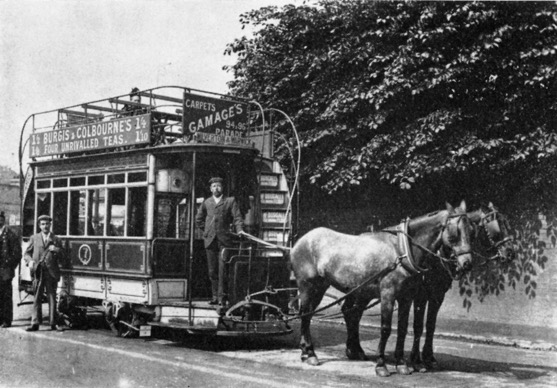
Leamington and Warwick Horse Tram No 7, which appears to be a Falcon Engine and Car Works product (delivered in 1895), at the Leamington terminus — photo undated, but probably taken in the late 1890s. Photo courtesy of the Tramways and Light Railway Society, with thanks to David Voice.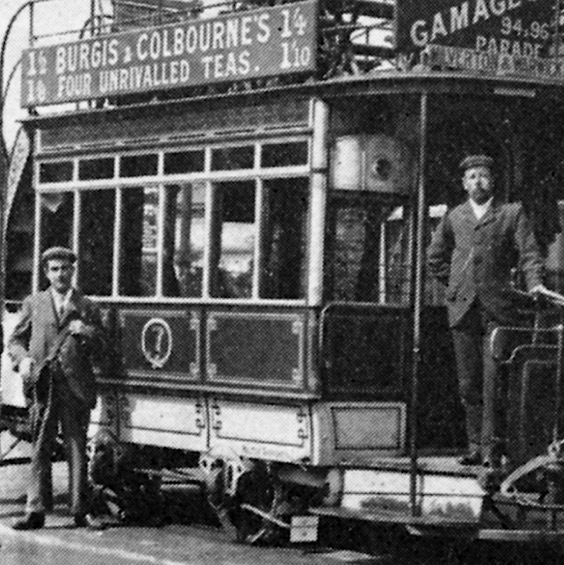
A blow-up of the above photo showing the conductor and driver, both of whom are in informal attire. The driver is George Powell and the conductor is Tommy Mumford.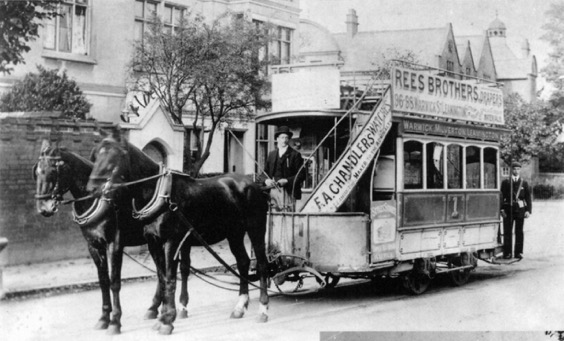
A rather battered looking Leamington and Warwick Horse Tram No 1 (certainly not the original car with that number) at the Avenue Rd terminus in Leamington— photo undated, but probably taken in 1903. Photo courtesy of the Tramways and Light Railway Society, with thanks to David Voice.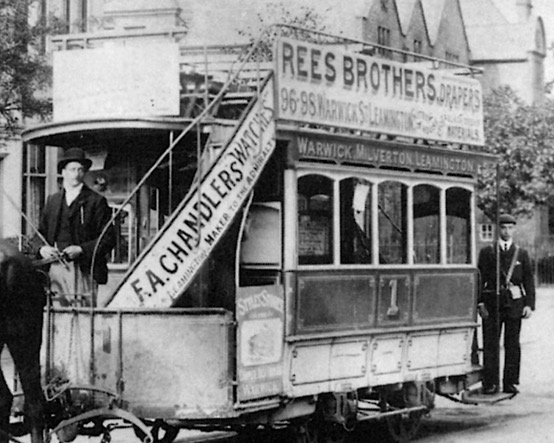
A blow-up of the above photo showing the crew, both of whom are wearing informal attire. The tram driver is James Claridge.
Motormen and conductors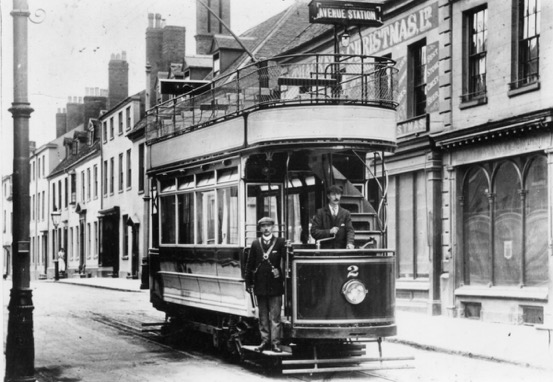
A brand new Tramcar No 2 at the Warwick terminus, seemingly without company markings — photo taken in July 1905, possibly prior to opening. Photo courtesy of the Tramways and Light Railway Society, with thanks to David Voice.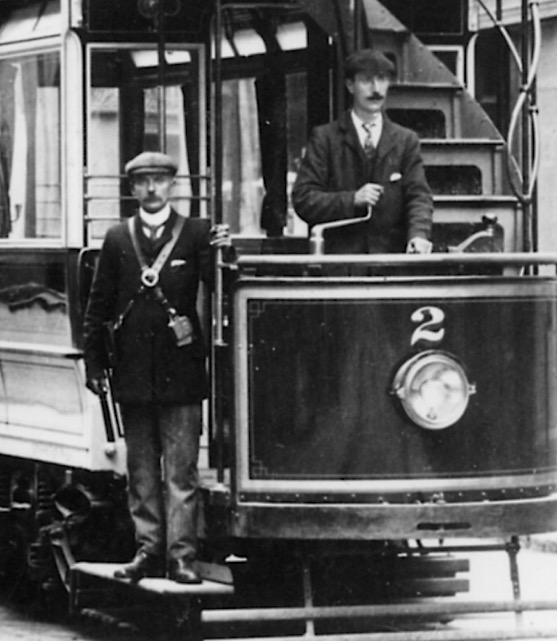
A blow-up of the above photo showing the crew, both of whom are wearing informal attire.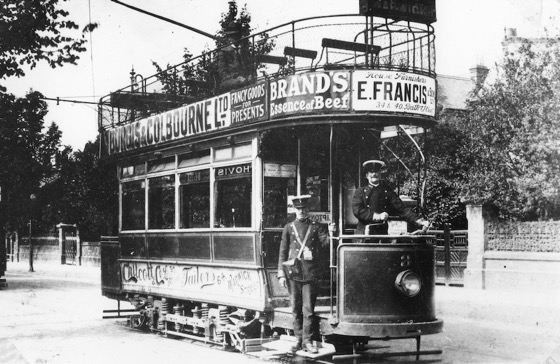
A conductor and a motorman with Tramcar No 3 at Milverton Station in BETCo days, i.e., some time between 1905 and 1912. Author's Collection.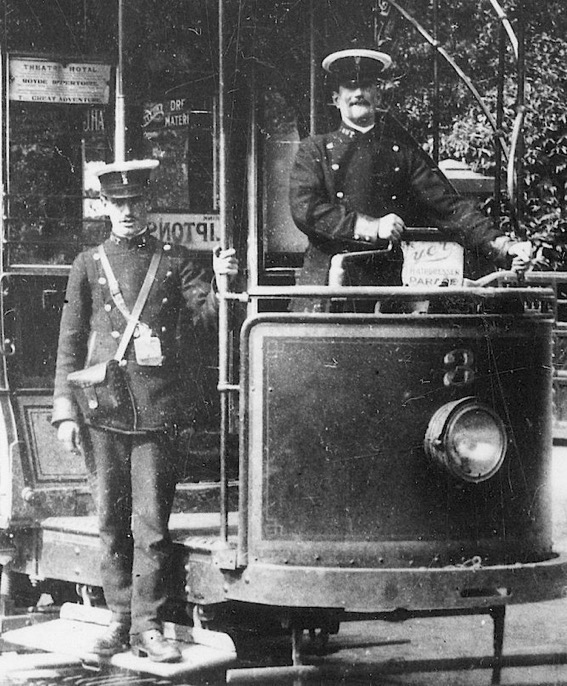
A blow-up of the above photo showing the crew, both of whom are wearing standard BETCo insignia: 'Magnet & Wheel' cap badge above an employee number, with an employee number on the bearer's left-hand collar and 'L & W T' initials on the right-hand collar.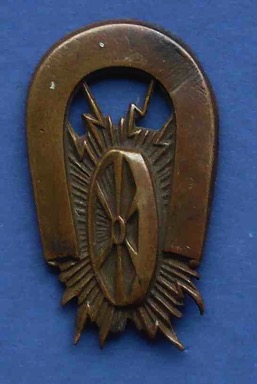
Standard British Electric Traction Company ‘Magnet & Wheel’ cap badge worn from 1905 to 1912 — brass. Author's Collection.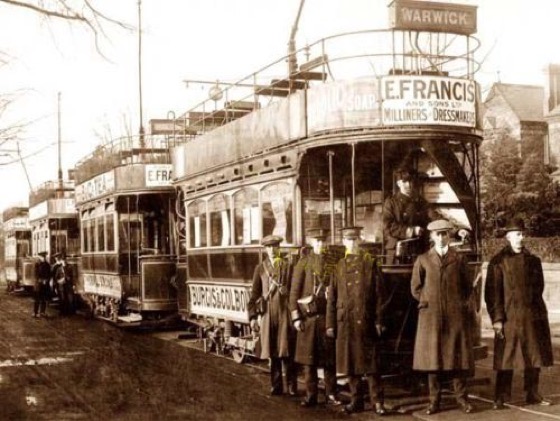
An array of staff and four trams — photo probably taken just after the Balfour Beatty take-over, as though the first tram still bears the BETCo's 'Magnet & Wheel' device, one of the staff is wearing a script-lettering grade badge.
General pattern script-lettering cap badges — Motorman and Conductor — of the type probably used by Leamington and Warwick Electrical Tramways from 1912 onwards.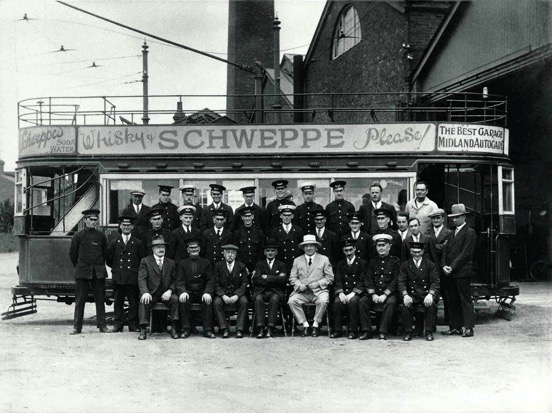
A photo of what is probably the entire staff of the tramway at Emscote Depot — the photo is believed to have been taken on the last day of operation, Saturday the 16th August 1930. Photo from the Peter Coulls Collection, courtesy of Allan Jennings.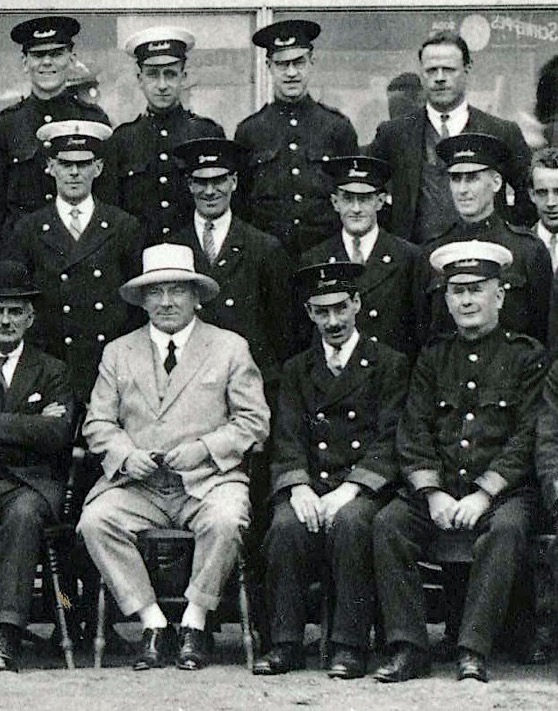
A blow-up of the above photo showing some of the motormen and conductors; the former are wearing double-breasted jackets with lapels, whilst the latter are wearing single-breasted jackets with upright collars and epaulettes. The only badges are on the script-lettering grade badges on their caps, which are Driver and Conductor, though one Motorman badge is also in evidence. This may be because by this time, staff were used interchangeably on the buses, which had been introduced in 1928.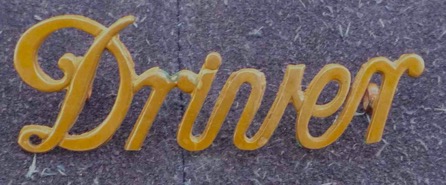
General pattern script-lettering cap badge — Driver — of the type used by Leamington and Warwick Electrical Tramways motormen late in the system's life. Author's Collection.
Senior staff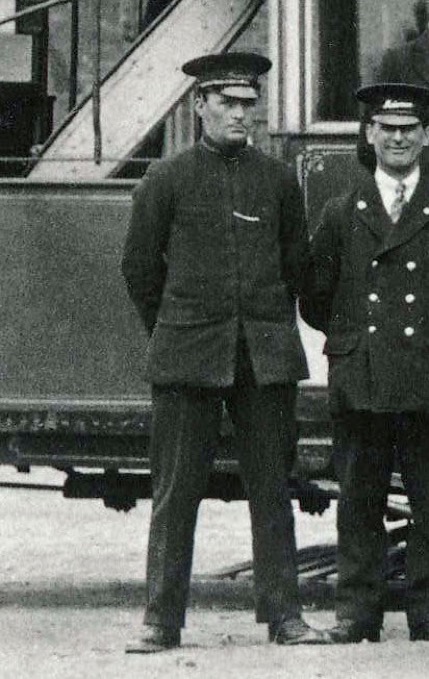
A blow-up of the 'last day' depot photo above showing the inspector. He is wearing a fairly typical tramway inspector's uniform with embroidered insignia.
Female staff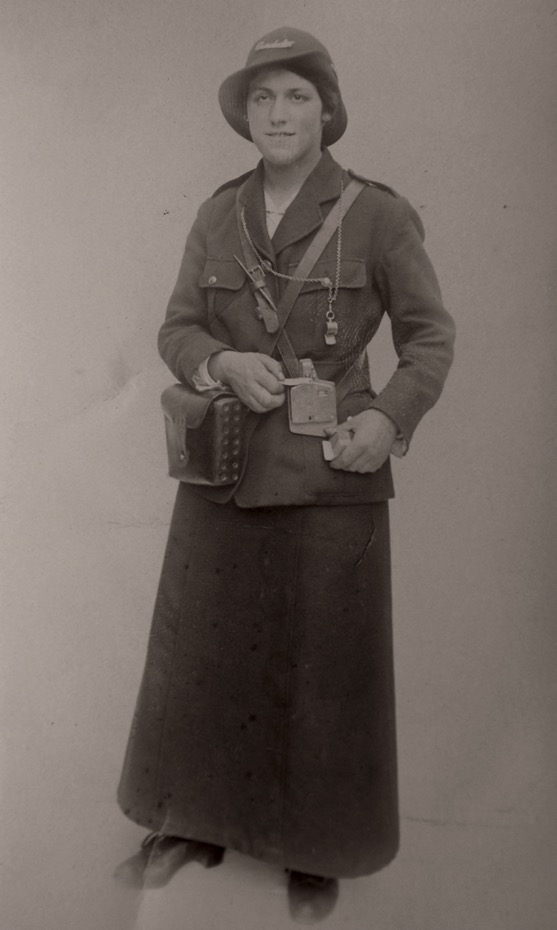
Leamington and Warwick Electrical Tramways conductress Nel Hewitt — photo undated, but almost certainly taken during the Great War. Photo courtesy of the Allan Jennings Collection.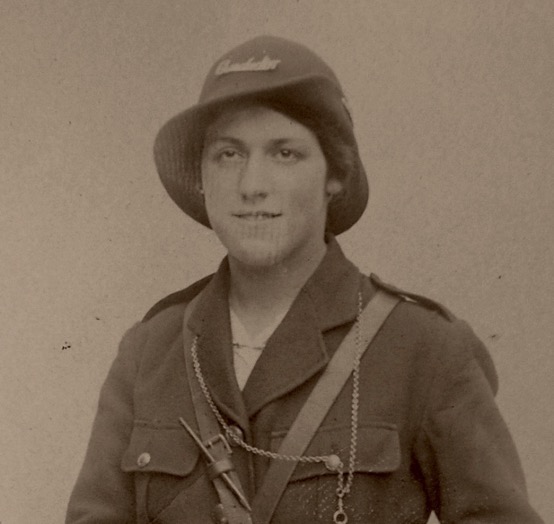
A blow-up of the above photo showing details of the uniform and cap. The photo is sharp enough to discern the buttons, which were plain with a scalloped rim, a type known to have been used on several other Balfour-Beatty systems (Dunfermline and District Tramways; Falkirk and District Tramways; Llandudno and Colwyn Bay Electric Railway; Wemyss and District Tramways).